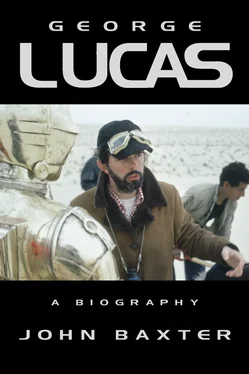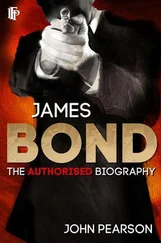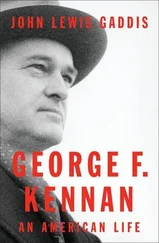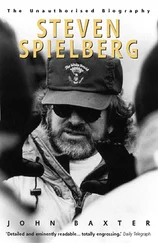Typical of Lucas’s later work, and of his life, the sexual initiative is taken by the woman. The film also has an undercurrent of homoeroticism. THX’s superior, SEN5241, played by British actor Donald Pleasence, is homosexual. His room-mate has just been ‘destroyed’ for unspecified reasons, and he reprograms the computer to have THX assigned to his living space.
LUH becomes pregnant, and both she and THX are arrested for drug evasion and sexual perversion. In the original screenplay, LUH is raped, then beaten to death on TV, but Lucas never shot these scenes, and we know no more of her fate than the fact that her name is reassigned to one of the countless embryos growing in ranked bottles in the city’s labs.
THX and SEN, convicted of interfering with the computer, are sent to a featureless white prison whose inmates remain out of fear of the surrounding formlessness, expending their energy in aimlessly plotting to escape. Exasperated, THX simply walks out, followed by SEN. In the white emptiness they meet SRT, a large, amiable black man convinced he isn’t real at all, but a ‘hologram’ who couldn’t make it on TV. They find their way back to the crowded corridors of the main complex, but SEN loses his nerve. Stumbling into the TV studio which broadcasts OMM’s image to the psychoanalysis booths, he humbly confesses his shortcomings to the poster-sized picture of the god stuck on the wall.
Awaiting arrest, he watches a group of children playing. All of them have bottles attached to an arm, from which ‘liquid education’ drips into a vein. One asks SEN to reconnect his tube, and he reminisces about the much larger containers through which one acquired knowledge when he was a boy. As the children gape in astonishment, the police arrive to take him away.
Meanwhile, THX and SRT steal jet cars, but the maladroit SRT can’t get his started, and when he does, promptly drives it into a pillar. THX rockets down a series of tunnels, pursued by the motorcycle police. At the end of the line he abandons the car and continues on foot. Lucas shot a scene in which THX falls into a garbage compactor and is menaced by a rat-like creature, but dropped it as unconvincing, only to recycle it in Star Wars . THX has less trouble with some scavenging Shelldwellers – bearded dwarfs, the progenitors of Star Wars ’ Jawas, who live in tunnels – and starts climbing a huge ventilation vent towards what he calls ‘the upper positive place.’ Two police are close to catching him when, abruptly, Control calls off the pursuit: it’s exceeded its budget. THX emerges on the surface, where he faces a presumably hopeful sunrise.
Lucas visualized the film in Panavision format, but that would have meant hiring expensive equipment. He compromised with Techniscope, a format popular with cost-cutting European and Asian producers looking to achieve wide-screen without special lenses. It simply cut the frame in half horizontally, producing an image half the height of conventional 35mm and twice the width, which nevertheless could be blown up to normal 35mm in the lab. Its deficiency was obvious: with half of a 35mm frame filling the same screen area as a full frame, the image risked being dark and grainy. But the Technicolor labs could print Techniscope prints direct from the original by using a dye-transfer matrix, avoiding the need to make a negative, so the quality was excellent, and remained so until they abandoned this method.
Other inventors found equally ingenious ways around the patents on various wide-screen systems. Paramount embraced VistaVision (‘Motion Picture High Fidelity!’), in which the film ran horizontally through the camera, offering a larger image than conventional 35mm. The clarity was superb, but the fact that it needed special cameras and projectors limited its use. Special-effects technicians, who loved the system for its large negative size, would rescue and restore Vista-Vision cameras to shoot the next generation of science fiction films, including Star Wars .
Lucas was delighted to be directing his first feature film. His budget might not be much in Hollywood terms, but his family was astonished at his achievement at only twenty-five years old. On the other hand, directing was daily torture, a constant process of revision and improvisation, with the ten-week production period ticking off in his brain every instant.
San Francisco’s new subway, the Bay Area Rapid Transit system (BART), was under construction, and Lucas persuaded them to let him shoot in the completed tunnels. Other sequences were shot in parking stations, Frank Lloyd Wright’s Marin County Civic Centre in San Rafael, and at the Lawrence Livermore atomic energy laboratory. The tiny crew moved between locations in one of the vans in which Coppola had crossed the country during the shooting of The Rain People .
Robert Duvall from The Rain People played THX, and Maggie McOmie LUH. Veteran Ian Wolfe was one of the prisoners windily discoursing on the nature of freedom. Knowing Lucas’s discomfort with actors, Coppola told Ron Colby to choose people who wouldn’t need more than a hint from the director, but Lucas still wrangled with them. Using a technique he would continue on American Graffiti , he shot most scenes with two cameras simultaneously. ‘That captures emotional stunts it’s hard to get after the first take,’ says Duvall.
Coppola imposed his crony Larry Sturhahn on the film as producer. If Lucas could ever have been comfortable with any supervisor, it was certainly not Sturhahn, who, he charged, spent most of his time on the phone, and hung up only to interfere. Coppola later confessed that he knew the two men wouldn’t get on. ‘George,’ he said, ‘needed someone to hate.’ As long as he could direct his animosity towards Sturhahn, he wouldn’t be blaming Coppola.
The pressure of too little money and not enough time encouraged improvisation, some of it inspired. Lucas tinkered together models and fireworks to create the film’s few special effects, like an explosion on the robot assembly line. Nobody was happy to have their head shaved, as was required of the whole cast, and there was a shortage of extras until someone thought to approach the drug rehabilitation centres Synanon and the Delancey Street Foundation. Enrolment required addicts to shave their heads as a sign of commitment, and most were happy to earn a few days’ wages as extras in the film.
Working with limited lights and a hand-held camera fitted with a thousand-meter telephoto lens pushed Techniscope to its limits. Warners, who, as the financing company, automatically saw the daily rushes, began muttering about the photographic quality. There was a growing sense that Coppola had sold them a pig in a poke. They held off breaking openly with him for only one reason: Patton . Franklin Schaffner’s film of Coppola’s screenplay opened on 5 February 1970, and, despite reviews which fretted about its jingoism, proceeded to make a fortune. Anyone that good, reasoned some within Warners, was worth cutting a little slack. But only a little. Lucas characterized their attitude as: ‘We’re the king and you’re the serfs.’
The attic at Mill Valley became a cutting room, and Lucas spent most nights there with Marcia, editing. At the same time, Walter Murch cut the sound – ‘Not,’ Lucas agrees, ‘the way things usually were done.’ Traditionally, movie mixers aimed for clarity, arguing that most cinemas had such poor sound systems that the audience was lucky to hear anything. Lucas wanted THX1138 to have a ‘musical’ quality, which Murch took to mean a sense of continuous ambient sound, sometimes almost inaudible. The layering of sounds had always fascinated Murch, and he’d developed a technique called ‘air-balling,’ in which one sound envelops but never quite obscures another. Renaissance composers for the unaccompanied voice routinely employed this effect, which may be where Murch got the idea, but nobody had yet applied it to film. Murch’s experiments spurred Lucas to pioneer better cinema sound. The new system would be called ‘THX Sound,’ and its slogan would be, ‘The Audience is Listening.’
Читать дальше












